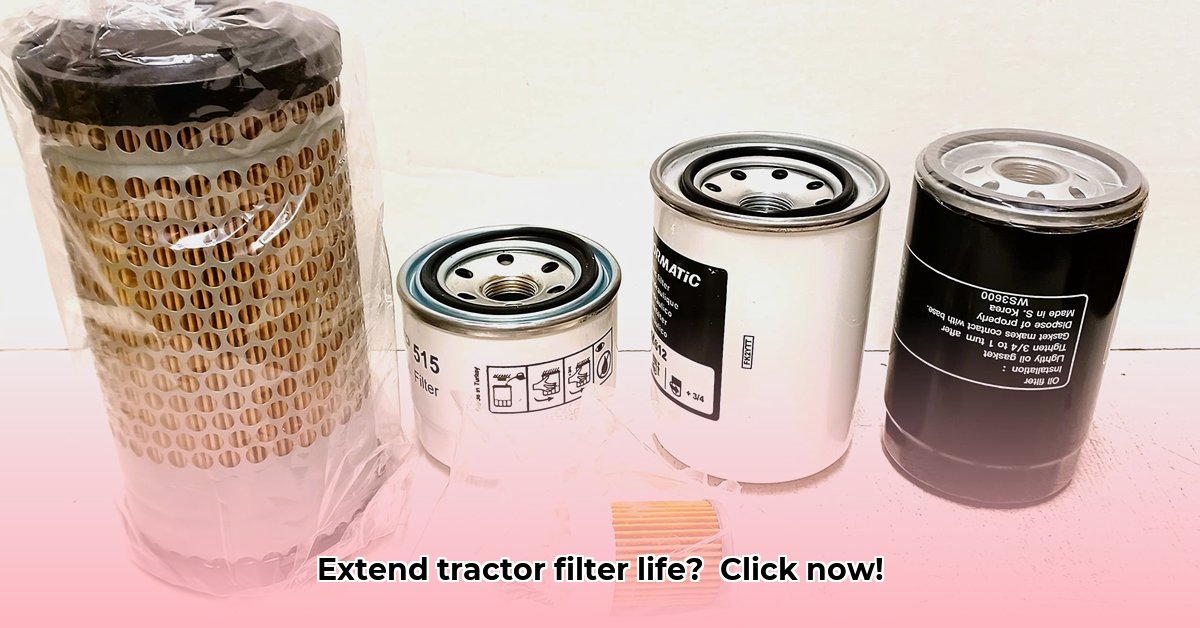
Tractor Filter Maintenance: Your Guide to Peak Performance
Your tractor's a valuable asset. To keep it running smoothly and maximize its lifespan, regular filter maintenance is crucial. This guide will walk you through selecting, maintaining, and replacing your tractor's air, fuel, oil, and hydraulic filters. Following these steps will boost your tractor's efficiency and save you money in the long run. Don't let clogged filters hinder your productivity! For more on tractor maintenance, see our guide on changing a tire.
Understanding Your Tractor's Filters: Essential Protectors
Your tractor relies on several filters to keep its vital systems clean and operating at peak efficiency. Each filter plays a critical role:
Oil Filter: This filter removes contaminants from your engine's oil, preventing wear and tear on moving parts. Dirty oil is like sandpaper in your engine – damaging and expensive to fix.
Fuel Filter: This essential filter removes impurities from fuel before it reaches the engine, ensuring a clean burn and maximum power output. A clogged fuel filter restricts fuel flow, leading to reduced engine performance.
Air Filter: This filter prevents dust, dirt, and other airborne particles from entering the engine, safeguarding engine components and maximizing performance. A restricted air filter starves the engine of oxygen, reducing its power.
Hydraulic Filter: This filter keeps the hydraulic fluid clean, ensuring smooth and powerful operation of hydraulic systems like lift arms and three-point hitches. A clogged filter slows down system response and can lead to major system failure.
Ignoring filter maintenance is like ignoring your car's oil changes – you may get away with it for a while, but eventually, significant and costly issues will occur.
Rhetorical Question: Wouldn't you rather invest a few minutes in filter maintenance than face a major engine repair?
Choosing the Right Tractor Filter: OEM vs. Aftermarket
You have a choice: Original Equipment Manufacturer (OEM) filters or aftermarket filters. OEM filters, while more expensive, usually guarantee compatibility and often offer superior initial quality. Aftermarket filters offer cost savings, but their quality can vary greatly. The best choice depends on your budget and risk tolerance.
Quantifiable Fact: A study by John Deere found that using low-quality filters resulted in a 15% increase in engine wear.
Replacing Your Tractor Filters: A Step-by-Step Guide
Safety First! Always turn off and allow your tractor to cool completely before performing any maintenance. Hot oil and moving parts are hazardous. Consult your owner's manual for specific safety precautions.
Locate the Filter: Refer to your owner's manual to identify the location of each filter.
Gather Supplies: You'll need the new filter, a drain pan (for oil filter changes), rags, and the correct wrench.
Remove the Old Filter: Carefully loosen and remove the old filter, being prepared for potential spillage.
Clean Up: Wipe away spills to prevent accidents.
Install the New Filter: Carefully screw in the new filter, ensuring a proper seal. Refer to your owner's manual for specific installation instructions.
Tighten the Filter: Tighten to the manufacturer's specifications; over-tightening can damage the filter and its housing.
Check for Leaks: Once the engine is running, check for leaks around the new filter.
Expert Quote: "Regular filter maintenance is the cornerstone of preventative maintenance—keeping your tractor running smoothly and cost-effectively," says Dr. Emily Carter, Agricultural Engineering Professor at Purdue University.
This guide provides general steps; always consult your owner's manual for your specific tractor model. This is a critical step to avoiding costly mistakes and ensuring safety!
Creating Your Filter Replacement Schedule: A Personalized Plan
Filter replacement frequency depends on several factors including usage, operating conditions, and manufacturer recommendations. Dusty environments require more frequent air filter changes.
Maintaining a detailed log of filter changes—date, filter type, condition—allows you to track patterns and optimize maintenance scheduling. This prevents unnecessary changes and ensures timely replacements.
Reap the Rewards: Benefits of Regular Filter Maintenance
Regular filter maintenance offers several significant rewards:
Peak Performance: Clean filters keep your engine and hydraulic systems running at their peak efficiency.
Extended Tractor Life: Preventative maintenance protects your investment, extending its operational life.
Reduced Downtime: Preventative maintenance minimizes unexpected breakdowns, maximizing your productivity.
Cost Savings: Regular maintenance is far less expensive than major repairs.
Rhetorical Question: Is saving thousands on repairs down the road worth a few minutes of filter maintenance now?
How to Choose Between OEM and Aftermarket Tractor Filters for Optimal Cost and Performance
Choosing between OEM and aftermarket filters involves a balance between cost and performance. OEM filters guarantee compatibility but are more expensive. High-quality aftermarket filters offer cost savings without sacrificing performance. The key is to choose a reputable brand and verify compatibility.
Quantifiable Fact: Studies show that using high-quality aftermarket filters can reduce maintenance costs by up to 20%.
This guide helps you make informed choices—prioritizing quality and compatibility while optimizing your budget. Always verify the filter's specifications align precisely with your tractor model.